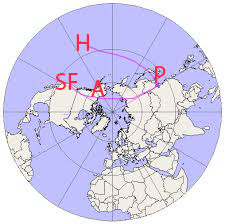It helps to see these distances on a polar map. Don't mind my messy lines.
 |
| Original Polar Map from Winwaed blog |
Pyongyang to Anchorage = 3564 air miles
Pyongyang to Honolulu = 4597 air miles
Pyongyang to San Francisco - 5597 miles
Does my title question strike you as alarmist? I'm sure that a lot of people in Houston are asking themselves if they should have heeded warnings, warnings that said climate change was making more forceful storms and that Houston's development in open areas needed to drain water in a flood plain would result in disastrous floods.
With the news this weekend of a much larger nuclear weapon than previously tested in North Korea, I think it's reasonable to ask this question about staying or moving. So let's look at the key questions:
1. Can and will North Korea build a bomb and intercontinental ballistic missiles capable of reaching Anchorage in the next year or two? It's looking increasingly possible.
2. If they can, would they use them to target the US? Americans have a highly distorted view of the world. In our minds, its ok to have troops and ships and planes stationed all over the world, yet we got crazy when the Russians tried to put missiles into Cuba in 1962. Other countries also don't like 'enemy' troops so close by. We've had troops in South Korea since we fought North Korea in the 1950s. Of course the North feels threatened. We like to joke about how crazy the North Korean leadership is (and it's certainly unique in the world today), but according to a Heritage Index of 2017 US Military Strength the US has
"some 54,000 military personnel Department of Defense civilian employees in Japan" and "maintains some 28,500 troops in Korea."Yet any attack on the US by North Korea, let alone a nuclear attack, would be suicide. But if they thought we were attacking them, I don't doubt that they would attack us - if they could - as well as the much more populated nearby South Korean target. That 'mutual assured destruction' was supposed to be the deterrent during the Cold War.
3. If they could and they would, would Anchorage be the target? Hawaii probably has much more appeal. There are more people in Honolulu and a large US military presence. When the Japanese attacked Pearl Harbor, the US military presence in Alaska was tiny in comparison. Seattle and San Francisco and Los Angeles are much better targets. But Anchorage is closer.
Today Anchorage has a joint army/air force military base with a combined population of about 11,600. The US tests anti-ballistic missiles from Kodiak, Alaska against potential attacks from North Korea which would make a tempting target as well.
The most compelling reason, in my mind, to attack Anchorage is that it is the closest US target, meaning the US defenses would have less time to respond.
4. What could stop them?
- Chinese and Russian influence on North Korea
- Economic sanctions - these could make it impossible to complete their weapons, or it could just make them more desperate.
- Conducting ourselves less threateningly - if Pyongyang thinks a US attack is imminent, if we could find a way to convince the that's not the case, it might work. But if preparing for a US attack is simply a way to keep the North Korean population afraid of war and supportive of the government, it won't.
- Anti-ballistic missiles maybe. They seem to have a spotty record with targets they knew were coming.
So, is it time to look at real estate outside of Anchorage? I'm sure few Alaskans are going to move at this point because of North Korea. While Alaska did have a monster earthquake in 1964, relatively few people died and most people here now, weren't here then. We feel safe. Just as the people of Houston did a few months ago. Moving means disrupting our lives. But if the odds of an attack seem low, the odds of surviving a successful attack would be nil. Only a tiny fraction of the people in Houston died. That wouldn't be the case here.

















